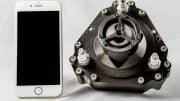
The researchers emphasize that their results do not, however, indicate that individuals should no longer pre-heat their vehicles.
Recent research from Finland, conducted by the University of Eastern Finland and Tampere University, assessed particulate emissions from passenger cars preheating with an auxiliary heater in subzero temperatures. The preheating emissions were compared to estimated driving emissions to calculate the driving distance corresponding to the preheating emissions under current emissions standards.
The study’s results were published in the journal Atmospheric Environment: X. The researchers measured auxiliary heater (AH) particulate emissions from the preheating of three gasoline and three diesel cars over a period of 30 minutes. Preheating was done outside in sub-zero conditions, which is when the AH manufacturer recommends preheating.
According to current emissions standards, using an auxiliary heater for 30 minutes was comparable to driving a car 97 kilometers (60 miles) on gasoline or 20 kilometers (12.4 miles) on diesel.
“When driving short distances, vehicle preheating can produce significantly higher particulate emissions than the actual drive, especially when considering that the during-drive emissions of most cars are much lower than the limits set in the emissions standards,” says Doctoral Researcher Henri Oikarinen of the University of Eastern Finland.
Auxiliary heaters contribute significantly to preheating emissions during heater startup and shutdown. This is especially true for diesel-powered heaters, where constant heating (i.e., not switching the heater on and off) generates less than one-third of the preheating emissions. Additionally, it was found that a sizeable portion of the particles produced by auxiliary heaters were in the smallest nanometric range: more than 50% of the particles produced by heaters fueled by gasoline and more than 90% of the particles produced by heaters powered by diesel were in the range below 23 nm.
“However, preheating extends the life cycle of the vehicle and also makes driving more comfortable. These findings do not suggest that people should stop preheating their cars; instead, we could reduce the emissions from preheating by using similar emissions reduction methods that are in place for engine emissions, also for fuel-operated auxiliary heaters. Fuel-operated heaters could also be switched for electric ones,” Senior Researcher Panu Karjalainen of Tampere University says.
Current vehicle emissions standards apply to particles above 23 nanometres in size, i.e., the observed large quantity of particles below 23 nanometres in size is significant and raises the question of whether the emissions of these smaller particles, too, should be regulated.
In new cars, an auxiliary heater may be needed also during a drive
Fuel-operated auxiliary heaters are used for heating vehicles in cold conditions. Auxiliary heaters are commonly known as ‘Webasto’ or ‘Eberspächer’, which are the largest AH manufacturers. Particulate emissions from auxiliary heaters are not regulated by legislation, and research into these emissions is scarce. As a result, the impact of AH emissions on air quality and, consequently, on health and the global emissions budget, remains unknown. However, studying AH emissions is essential to gain an accurate understanding of the total emissions from vehicles.
In recent years, vehicle engine emissions have been significantly reduced by emission after-treatment methods such as particulate filters and carburetors, and by improving engine efficiency. Existing auxiliary heaters, however, do not have similar after-treatment methods that are in place for vehicle engine emissions.
The significance of AH emissions is emphasized especially for certain new vehicle models whose engine performance is so efficient that they do not produce enough heat during the drive in sub-zero conditions. In these cases, an auxiliary heater is needed for heating the vehicle also during the drive.
“Since AH emissions are currently not taken into account in vehicle emissions standards, it is possible to sub-optimize regulated vehicle engine emissions by using an auxiliary heater, even if this wouldn’t make sense in view of the total emissions,” Research Manager Santtu Mikkonen of the University of Eastern Finland says.
Reference: “Particle number, mass, and black carbon emissions from fuel-operated auxiliary heaters in real vehicle use” by Henri Oikarinen, Miska Olin, Sampsa Martikainen, Ville Leinonen, Santtu Mikkonen and Panu Karjalainen, 24 September 2022, Atmospheric Environment: X.
DOI: 10.1016/j.aeaoa.2022.100189









Complete waste of time. My 5 year old granddaughter could have figured that out in 2 minutes. You dummies spent months and way too much cash to say this bull that does not matter! Next time spend that cash finding out how to get more rice from a harvest or more rain from a cloud. QUITE WASTING CASH on nonsense
I thought this was common knowledge, why did they need a study on this?
The longer it takes to get your engine up to operating temp the more emissions it produces due the catalytic converter not operating at maximum efficiency.
The quickest way to get an enigne up to temp is driving the vehicle and putting it under load.
Of course just sitting there makes the engine produce tons of emissions, THE CAR ISNT MOVING!!!
“… vehicle engine emissions have been significantly reduced by emission after-treatment methods such as particulate filters and CARBURETORS, …”
I believe the author meant to say “catalytic convertors,” NOT carburetors.